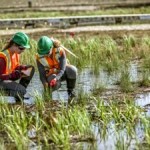The short introductions to some of the initiatives and the overview of all projects show the variety and diversity of initiatives under way in terms of implemented activities, objectives, carbon market orientation, size and location. Most of the initiatives are recent and under development. The entry points to the projects are all linked to unsustainable or low productivity land management practices, having caused land degradation.
The projects’ direction is generally towards improving the agricultural or forestry practices by introducing new techniques, as well as rehabilitating degraded soils. Agroforestry is a practice that is part of many of these GHG mitigating projects, because it contributes both above- and below-ground to carbon sequestration, as well as providing other important co-benefits. Conservation agriculture is another technique that plays an important role in climate-friendly projects, as well as organic production techniques and bioenergy.
Some of the projects from this inventory have a carbon market orientation as they aim to generate carbon credits to be sold on markets. These are all at different stages, with only two projects in the payment phase. Several projects are in the feasibility or planning phases and still need to undergo the preparation of the documentation material for a carbon project to be submitted to the voluntary or regulatory market. In addition, there are several projects aiming to reduce the release of GHGs by introducing new techniques and providing carbon sinks but that do not foresee generating carbon credits from these activities.
A striking feature of the survey projects is the multiplicity of benefits in terms of adaptation, productivity increases and support to development objectives. Many important environmental benefits are seen off-site. They seem to be a generic feature of mitigation practices and should be taken into account when considering possible mechanisms for the payment of environmental services.
It makes eminent sense to adopt climate smart farming practices with important synergies between productivity, adaptation and mitigation. The environmental services provided by the farmers should be remunerated in some way. The specific demands of the agricultural production, the need for investments for improved farming practices, the slow process of the accumulation of carbon, and the time lag for increased productivity all create a challenge for financial mechanisms that could facilitate the transformation of current agricultural systems to climate smart agriculture.
Similarly, the sheer number of the farming units and their generally relatively small size and modest amount of carbon accumulated per hectare all call for innovative rethinking in financing systems. The lessons learned from PES schemes can already provide some indications for the direction to follow, and additional lessons can be drawn through these new types of projects; however, there is also need to quickly adjust financing and accounting systems in order to integrate smallholder farmers into agricultural mitigation activities so that they may reap the full benefits. Therefore, it will be truly significant to follow the activities and, it is hoped, increase opportunities for all those interested to share lessons and learn from each other.
Click here to download Complete Report:













